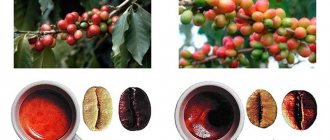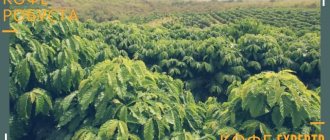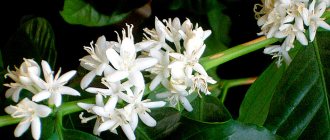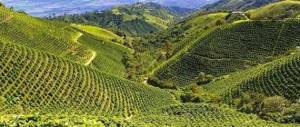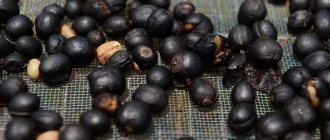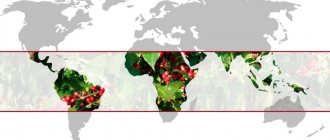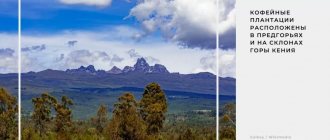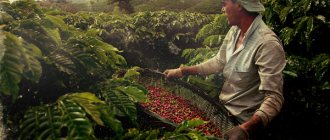General information about Arabica
Arabica is a coffee tree from the genus of evergreen plants.
This is a high-yielding tree. The main feature of its fruits is its relatively low caffeine content. Thus, a drink made from them has a gentler effect on the human body.
The plant was first described by the Swedish scientist Carl Lineus. Much later, genetic studies revealed that this type of coffee tree is a hybrid. It differs from other varieties by the presence of four chromosomes instead of two.
A genetic mutation largely determined the taste of the berries.
Origin story
Arabica arabica (Coffea Arabica) is the result of a natural crossing of two types of coffee trees: Eugenioides and Robusta. The plants grew close together, which allowed pollen from one to fall into the flowers of the other. It is believed that this happened in Ethiopia.
The mother plant was Eugenioides, and the father plant was Robusta. Their offspring became the basis for the emergence of a new species. Around the 9th century. Coffee berries became popular among warriors, shepherds and monks who operated in Ethiopia. Later the Arabs tried them. They contributed to the spread of this Arabic type of coffee.
Where does the coffee tree grow?
The natural habitat for Arabica is the vast area between Sudan, Ethiopia and Kenya. Wild coffee trees are unpretentious and are often found in mountainous areas at altitudes from 600 to 2500 m above sea level. The optimal temperature for this plant is between 15 and 25°C. Human activity has led to the spread of this type of coffee tree. Now it is grown in many countries of the equatorial belt, including:
- Venezuela.
- Salvador.
- Costa Rica.
- Cuba.
- Peru.
- Bolivia.
- Brazil.
- Colombia.
- Uganda.
- Haiti.
- Zambia.
- Rwanda.
- Tanzania, etc.
External description: flowers, fruits and seeds
This is an evergreen tree that grows up to 10 m. However, to obtain fruit it is pruned, forming a dense crown not exceeding 2 m in height. This makes the process of picking berries easier. The lifespan of the plant is 50-60 years. It bears fruit most intensively during the first 15 years. Subsequently, the number of berries decreases. Arabica flowers bloom throughout the year. On one tree you can find not only open buds, but also green and already ripe fruits.
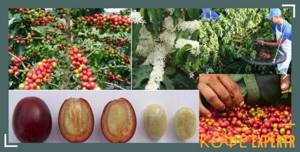
Arabica fruits ripen 6-7 months after flowering.
The leaves of the coffee tree have an oval-elongated shape. White flowers are located on both skeletal and peripheral branches. They appear in bunches of 5-8 pieces. Only a few of them are pollinated and form an ovary. The flowering period lasts about 2-3 days.
The formation and ripening of fruits takes about 9 months. Ripe berries acquire a red tint and a glossy shine. The pulp becomes juicy and sweet, attracting birds and animals that can become seed carriers. The stone located inside is bicotyledonous. In its raw form, it has a green-brown color.
Compound
Arabica beans have relatively low caffeine content, reaching 1-1.5%. At the same time, the level of beneficial essential oils is 18%, and sugar up to 8%.
In addition, the product contains a lot of plant fiber.
What is Arabica
Of all the varieties of coffee, Arabica is the most popular. It has earned this reputation for its unique taste and aroma. The small evergreen tree produces fruits that are well known to everyone. In a year, more than half of the world's supply is obtained from the plantations where coffee grows. The caffeine content in Arabica is very small, only 1-1.5%.
Arabica coffee beans are one of the most expensive types of coffee. This is due to the fact that its cultivation requires considerable funds, which are spent on the purchase of insecticides and fertilizers.
Features of cultivation
This type of coffee tree is unpretentious, but the best yield is achieved in mountain valleys, where high humidity and temperature remain throughout the year. Under such conditions, it is possible to obtain up to 4 grain harvests per year. In addition, the chemical composition of the soil suitable for this plant has a positive effect on fruiting.
The flavor of the beans varies depending on which region they come from. When grown on poor soils in arid conditions, where a short-term temperature drop below 15°C is possible, it is possible to obtain a harvest once a year. On average, one tree produces from 2 to 5 kg of berries.
Nowadays coffee is grown on extensive plantations. Gentle hillsides are often cultivated for this tree. The plant requires systematic pruning to prevent excessive branch spread. The berries are picked manually.
Taste characteristics
Unlike other varieties of coffee, the berries of this plant, after processing, produce a drink with a slight sourness. Bitterness is weakly expressed. This is due to the low caffeine content.
Factors affecting taste
First of all, the composition of the soil and the climatic conditions in which the tree grew are important.
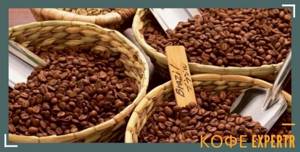
The taste of coffee depends on where the Arabica grows.
In addition, the method of collection and primary processing affects the quality. Ground coffee is less resistant to transportation than grain coffee. The taste of the product is also influenced by proper storage.
Places of growth
The homeland of Arabica is East Africa. It was there that these trees were first noticed. They were subsequently popularized on other continents. Coffee began to occupy an important place in the world economy.
Many countries began to grow Arabica, but only Brazil, Indonesia and India were able to do this on an industrial scale.
At the moment, there are more than 40 types of Arabica in the world. Their name depends on various criteria, such as: manufacturer, country (region) of growth and degree of roasting of the beans.
All varieties are divided into groups. The best varieties of Arabica coffee belong to the highest category. Huge success among fans of the aromatic drink: Maragogipe, Bourbon and Typica. They were formed in the process of bud transformations. Many valuable varieties are produced in Africa.
Varietal varieties
During the breeding work, more than 20 varieties of Arabica were bred. They differ slightly in taste characteristics.
Bourbon
This is the first variety to be cultivated outside its natural range. It received its name in honor of the island of Bourbon, later renamed Reunion. This type of coffee tree produces many side branches that grow at a slight angle to the crown. The berries ripen within 5-7 months. They are fragile and not very resistant to weather changes. The color of the fruit is yellow, red and pink. This is caused by a mutation in a recessive gene. The coffee has a slight caramel flavor.
Typika
This is a classic Arabica coffee that originated in Ethiopia. The crown of the trees has a conical shape. There is a coppery sheen on the leaves. The berries have a wide oval shape. The drink has a pronounced sour taste.
Ethiopian heritage
This is a commonly found wild variety. Now it is actively grown in Latin America. The berries are processed dry. Thanks to this, the drink acquires light citrus and floral notes.
Catuai
The plant is unpretentious and resistant to environmental factors. It is grown in high mountain areas. Obtained by crossing the Caturra and Mundo Novo varieties. Red fruits are the most valuable because... their grains give the drink a more pronounced sourness.
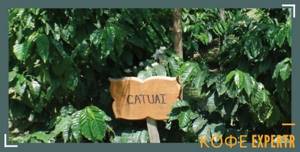
Arabica variety Catuai is a compact plant with green leaves and medium-sized coffee beans.
Mundo novo
This variety is a hybrid of bourbon and typica. The crossing happened naturally. The tree was first identified in Brazil. It is highly resistant to disease and produces large yields. The berries ripen within 10 months. The acidity of the fruit is low. There is a faint creamy aftertaste.
Caturra
This is an Arabica variety developed in Brazil. It is obtained by fixing a natural mutation of bourbon. The variety is highly productive, but whimsical and requires the creation of special conditions. The berries have high acidity.
Geisha
A variety that is grown in Panama at an altitude of about 1400 m. It produces low yields. However, the fruits are highly valued because... have an unusual jasmine aroma.
Katimor
An Arabica variety developed in Portugal. The fruits ripen on average in 5-7 months. Gives high yields. Trees grow up to 2.5 m. Can be grown at an altitude of more than 1 thousand m above sea level.
Pacas
This variety was created as a result of a natural mutation of bourbon in El Salvador. It is characterized by high yield and good disease resistance. Valued for the pronounced acidity of the berries.
Timor
This variety was developed by crossing Typica and Robusta. It was named after the island of Timor. This species has not become widespread.
Maragogyp
A variety resulting from a mutation of the typica. They are grown in the mountains at an altitude of 1.8 thousand m above sea level. The grains are highly valued due to their special aroma and caramel taste.
Historical reference
Arabica was mentioned in the 6th century. It was originally grown in Yemen and Ethiopia. The world was content with only these coffee berries until the beginning of the 20th century, only later did other species appear.
The historical homeland is the lowlands of the rivers of the Kefa Valley. There you can still see wild trees located 2000 meters above sea level.
At the end of the 19th century, many farmers were forced to stop cultivating the popular plant due to disease, and it was replaced by other crops. At the same time, they began to work on the Robusta type coffee tree in Indonesia. It had high yields and amazing resistance to disease, but the finished drink was of low quality.
In the first half of the 20th century, breeders carried out work in three directions to adapt the plant to cultivation in local conditions, while simultaneously increasing the yield and improving the quality of the drink. After 20 years, agronomists from different countries have adopted a plan that will help make Arabica more resistant to disease.
Features of roasting beans
There are many ways to process coffee beans. They help preserve the properties of the product and increase the shelf life of raw materials.
Four degrees
There are 4 degrees of roasting of coffee beans:
- Light - involves frying raw materials until a light golden brown color appears. With this processing, the product most fully retains its mild taste and characteristic sourness.
- Medium - when processed, the grains acquire a dark shade. A slight oiliness should appear on the surface of the raw material. The drink has a moderate taste.
- Strong—the beans are roasted until they turn black. There is a slight burning smell. Because of this, the drink has a characteristic bitter taste.
- Extreme - the grains are fried until charred. The drink has a black color, a burning smell and a bitter taste.
Three modern technologies
Relatively recently, 3 new processing methods have emerged that help preserve the natural taste of grains:
- Thermal. The technology involves filling 2 tons of raw materials into a special drum. It is set in motion. In this case, heat treatment is carried out with air heated to 200°C.
- Dielectric. The technology involves placing grains in a special apparatus, where the raw materials are exposed to frequency waves.
- Infrared. In this case, the coffee is processed using infrared waves. Using a special program, a special pressure and temperature regime is set. During processing, the grains increase in size, but their taste does not change.
Seven classic ways
The classic methods of processing coffee beans include:
- French.
- Viennese.
- Scandinavian.
- Italian.
- American.
- Cinnamon.
- Urban.
Arabica beans
Ripe Arabica beans are flat-convex, slightly elongated in shape with an S-shaped hollow in the center. Unprocessed grain seeds have an emerald gray or bluish tint.
They are very large in size, larger than other types of beans, but they contain less caffeine. They contain a large amount of sugar (8%) and essential oils (15%). The protein content is about 13%.
Hand-picked fruits from coffee trees are washed, dried and roasted. As a result, they acquire a uniform chestnut color, the amount of caffeine, fats and nitrogen compounds increases, and the amount of acids and sugar decreases. 100% Arabica coffee has an intense aroma and great taste.
Coffee selection criteria
When purchasing, you need to be guided by your taste preferences. It is best to purchase products in grains and grind them at home.

It is recommended to buy Arabica beans and grind them yourself at home.
A drink made from light to medium roast coffee has a richer taste. The product of strong and extreme heat treatment has a strong taste and smell, so it is not suitable for everyone.
It is important that the country and production date are indicated on the packaging.
How to select and store
There are very specific and simple rules for choosing Arabica beans:
- It is important to pay attention to the smell. This variety differs from others in its rich, vibrant taste. If coffee beans become stale, they smell weak and develop notes of unpleasant bitterness;
- It is also necessary to look at how the grains look externally. If the beans are shiny and greasy, this means they have lost quality. Ideally, fresh grains should be dry and not cracked;
- Regardless of roast, the beans should be large, round and similar in size;
- You should look at how the product is packaged. It is preferable to store coffee beans in a vacuum;
- Manufacturer information. They must contain information about the country of origin, the name of the variety, the degree of roasting, the date of harvest and its packaging.
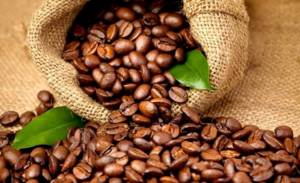
Arabica coffee is 100% natural coffee, its beans should be stored in closed glass containers until the expiration date marked on the container. It should be noted that, unlike ground coffee, freshly picked beans have a bright, rich taste.
In the absence of a coffee grinder at home, it is recommended to purchase ground coffee in small parts and always check the production date.

